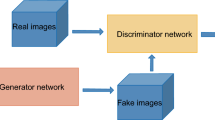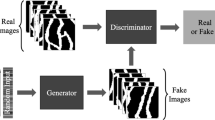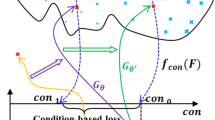Abstract
Subsurface models are central pieces of information in different earth-related disciplines such as groundwater management and hydrocarbon reservoir characterization. These models are normally obtained using geostatistical simulation methods. Recently, methods based on deep learning algorithms have been applied as subsurface model generators. However, there are still challenges on how to include conditioning data and ensure model variability within a set of realizations. We illustrate the potential of Generative Adversarial Networks (GANs) to create unconditional and conditional facies models. Based on a synthetic facies dataset, we first train a Deep Convolution GAN (DCGAN) to produce unconditional facies models. Then, we show how image-to-image translation based on a U-Net GAN framework, including noise-layers, content loss function and diversity loss function, is used to model conditioning geological facies. Results show that GANs are powerful models to capture complex geological facies patterns and to generate facies realizations indistinguishable from the ones comprising the training dataset. The U-Net GAN framework performs well in providing variable models while honoring conditioning data in several scenarios. The results shown herein are expected to spark a new generation of methods for subsurface geological facies with fragmentary measurements.
Similar content being viewed by others
References
Arjovsky, M., Bottou, L.: Towards principled methods for training generative adversarial networks. arXiv preprint arXiv:1701.04862 (2017)
Arjovsky, M., Chintala, S., Bottou, L.: Wasserstein gan. arXiv preprint arXiv:1701.07875 (2017)
Arpat, G.B., Caers, J.: Conditional simulation with patterns. Math. Geol. 39(2), 177–203 (2007)
Audebert, N., Le Saux, B., Lefèvre, S.: Generative adversarial networks for realistic synthesis of hyperspectral samples. In: IGARSS 2018-2018 IEEE International Geoscience and Remote Sensing Symposium 2018, pp. 4359-4362. IEEE
Azevedo, L., Nunes, R., Correia, P., Soares, A., Guerreiro, L., Neto, G.S.: Multidimensional scaling for the evaluation of a geostatistical seismic elastic inversion methodology. Geophysics. 79(1), M1–M10 (2014)
Azevedo, L., Paneiro, G., Santos, A., Soares, A.: Generative adversarial network as a stochastic subsurface model reconstruction. Comput. Geosci. 24(4), 1673–1692 (2020)
Caterini, A., Chang, D.E.: A Novel Representation of Neural Networks. arXiv e-prints (2016)
Caterini, A.L., Chang, D.E.: A geometric framework for convolutional neural networks. arXiv preprint arXiv:1608.04374 (2016)
Chan, S., Elsheikh, A.H.: Parametric generation of conditional geological realizations using generative neural networks. Comput. Geosci. 23(5), 925–952 (2019)
Cox, T.F., Cox, M.A.A.: Multidimensional scaling. Chapman & Hall/CRC, Boca Raton (2001)
Creswell, A., White, T., Dumoulin, V., Arulkumaran, K., Sengupta, B., Bharath, A.A.: Generative adversarial networks: an overview. IEEE Signal Process. Mag. 35(1), 53–65 (2018)
Daly, C., Caers, J.: Multi-point geostatistics–an introductory overview. First Break 28(9), 39–47 (2010)
Deutsch, C.V., Journel, A.G.: Geostatistical software library and user’s guide. New York 119(147) (1992)
Donahue, C., McAuley, J., Puckette, M.: Synthesizing audio with generative adversarial networks. arXiv preprint arXiv:1802.04208 1 (2018)
Drozdzal, M., Vorontsov, E., Chartrand, G., Kadoury, S., Pal, C.: The importance of skip connections in biomedical image segmentation. In: Carneiro G, et al. (eds.) Deep Learning and Data Labeling for Medical Applications. DLMIA 2016, LABELS 2016. Lecture Notes in Computer Science, vol 10008. Springer, Cham (2016). https://doi.org/10.1007/978-3-319-46976-8_19
Dupont, E., Zhang, T., Tilke, P., Liang, L., Bailey, W.: Generating realistic geology conditioned on physical measurements with generative adversarial networks. arXiv preprint arXiv:1802.03065 (2018)
Goodfellow, I.: NIPS 2016 tutorial: Generative adversarial networks. arXiv preprint arXiv:1701.00160 (2016)
Goodfellow, I., Pouget-Abadie, J., Mirza, M., Xu, B., Warde-Farley, D., Ozair, S., Courville, A., Bengio, Y.: Generative adversarial nets. In: Advances in neural information processing systems 2014, pp. 2672-2680
Hong, Y., Hwang, U., Yoo, J., Yoon, S.: How generative adversarial networks and their variants work: an overview. ACM Comput. Surv. (CSUR). 52(1), 1–43 (2019)
Hore, A., Ziou, D.: Image quality metrics: PSNR vs. SSIM. In: 2010 20th international conference on pattern recognition 2010, pp. 2366-2369. IEEE
Isola, P., Zhu, J.-Y., Zhou, T., Efros, A.A.: Image-to-Image Translation with Conditional Adversarial Networks. In: Proceedings of the IEEE conference on computer vision and pattern recognition 2017, pp. 1125-1134
Jetchev, N., Bergmann, U., Vollgraf, R.: Texture synthesis with spatial generative adversarial networks. arXiv preprint arXiv:1611.08207 (2016)
Karras, T., Laine, S., Aila, T.: A Style-Based Generator Architecture for Generative Adversarial Networks. In: Proceedings of the IEEE conference on computer vision and pattern recognition 2019, pp. 4401-4410
Laloy, E., Hérault, R., Jacques, D., Linde, N.: Training-image based geostatistical inversion using a spatial generative adversarial neural network. Water Resour. Res. 54(1), 381–406 (2018)
Laloy, E., Linde, N., Ruffino, C., Hérault, R., Gasso, G., Jacques, D.: Gradient-based deterministic inversion of geophysical data with generative adversarial networks: is it feasible? Comput. Geosci. 133, 104333 (2019)
Ledig, C., Theis, L., Huszár, F., Caballero, J., Cunningham, A., Acosta, A., Aitken, A., Tejani, A., Totz, J., Wang, Z.: Photo-Realistic Single Image Super-Resolution Using a Generative Adversarial Network. In: Proceedings of the IEEE conference on computer vision and pattern recognition 2017, pp. 4681-4690
Mao, Q., Lee, H.-Y., Tseng, H.-Y., Ma, S., Yang, M.-H.: Mode Seeking Generative Adversarial Networks for Diverse Image Synthesis. In: Proceedings of the IEEE Conference on Computer Vision and Pattern Recognition 2019, pp. 1429-1437
Mariethoz, G., Caers, J.: Multiple-Point Geostatistics: Stochastic Modeling with Training Images. John Wiley & Sons, Hoboken (2014)
Mariethoz, G., Renard, P., Straubhaar, J.: The direct sampling method to perform multiple-point geostatistical simulations. Water Resources Research 46(11) (2010)
Matheron, G., Beucher, H., De Fouquet, C., Galli, A., Guerillot, D., Ravenne, C.: Conditional simulation of the geometry of fluvio-deltaic reservoirs. In: Spe annual technical conference and exhibition 1987. Society of Petroleum Engineers
Metz, L., Poole, B., Pfau, D., Sohl-Dickstein, J.: Unrolled generative adversarial networks. arXiv preprint arXiv:1611.02163 (2016)
Mirza, M., Osindero, S.: Conditional generative adversarial nets. arXiv preprint arXiv:1411.1784 (2014)
Mosser, L., Dubrule, O., Blunt, M.J.: Reconstruction of three-dimensional porous media using generative adversarial neural networks. Phys. Rev. E. 96(4), 043309 (2017)
Mosser, L., Dubrule, O., Blunt, M.J.: Stochastic reconstruction of an oolitic limestone by generative adversarial networks. Transp. Porous Media. 125(1), 81–103 (2018)
Mosser, L., Dubrule, O., Blunt, M.J.: Conditioning of three-dimensional generative adversarial networks for pore and reservoir-scale models. arXiv preprint arXiv:1802.05622 (2018)
Pyrcz, M.J., Deutsch, C.V.: Geostatistical reservoir modeling. Oxford university press, Oxford (2014)
Radford, A., Metz, L., Chintala, S.: Unsupervised representation learning with deep convolutional generative adversarial networks. arXiv preprint arXiv:1511.06434 (2015)
Ronneberger, O., Fischer, P., Brox, T.: U-net: convolutional networks for biomedical image segmentation. In: International Conference on Medical image computing and computer-assisted intervention 2015, pp. 234-241. Springer
Sarkar, B.C.: Geostatistics in groundwater Modelling. In: Sikdar, P.K. (ed.) Groundwater Development and Management: Issues and Challenges in South Asia, pp. 147–169. Springer International Publishing, Cham (2019)
Song, S., Mukerji, T., Hou, J.: GANSim: Conditional Facies Simulation Using an Improved Progressive Growing of Generative Adversarial Networks (GANs). EarthArXiv. https://doi.org/10.31223/osf.io/fm24b (2020)
Strebelle, S.: Conditional simulation of complex geological structures using multiple-point statistics. Math. Geol. 34(1), 1–21 (2002)
Sun, A.Y.: Discovering state-parameter mappings in subsurface models using generative adversarial networks. Geophys. Res. Lett. 45(20), 11,137–111,146 (2018)
Wackernagel, H.: Multivariate Geostatistics: an Introduction with Applications. Springer Science & Business Media (2013)
Wang, Z., Bovik, A.C., Sheikh, H.R., Simoncelli, E.P.: Image quality assessment: from error visibility to structural similarity. IEEE Trans. Image Process. 13(4), 600–612 (2004)
Yang, D., Hong, S., Jang, Y., Zhao, T., Lee, H.: Diversity-sensitive conditional generative adversarial networks. arXiv preprint arXiv:1901.09024 (2019)
Yeh, R.A., Chen, C., Yian Lim, T., Schwing, A.G., Hasegawa-Johnson, M., Do, M.N.: Semantic Image Inpainting with Deep Generative Models. In: Proceedings of the IEEE conference on computer vision and pattern recognition 2017, pp. 5485-5493
Zhang, T.-F., Tilke, P., Dupont, E., Zhu, L.-C., Liang, L., Bailey, W.: Generating geologically realistic 3D reservoir facies models using deep learning of sedimentary architecture with generative adversarial networks. Pet. Sci. 16(3), 541–549 (2019)
Zhong, Z., Sun, A.Y., Jeong, H.: Predicting co2 plume migration in heterogeneous formations using conditional deep convolutional generative adversarial network. Water Resour. Res. 55(7), 5830–5851 (2019)
Zhu, J.-Y., Park, T., Isola, P., Efros, A.A.: Unpaired Image-to-Image Translation Using Cycle-Consistent Adversarial Networks. Proceedings of the IEEE international conference on computer vision, In (2017) pp. 2223-2232
Zhu, L., Chen, Y., Ghamisi, P., Benediktsson, J.A.: Generative adversarial networks for hyperspectral image classification. IEEE Trans. Geosci. Remote Sens. 56(9), 5046–5063 (2018)
Acknowledgements
The authors gratefully acknowledge the support of the CERENA (strategic project FCT-UIDB/04028/2020) and the National Key Research and Development Project of China (project number 2019YFA0708300). The authors also thank the student exchange program between China University of Petroleum (Beijing) and Instituto Superior Técnico. We acknowledge the two anonymous reviewers that contributed to increase the quality of the original version of this work.
Author information
Authors and Affiliations
Corresponding authors
Ethics declarations
Code availability
The U-NET GAN code used in this work can be accessed using the following link: ttps://github.com/kyle4git/U-Net-GAN-for-subsurface-facies-modeling.git
Additional information
Publisher’s note
Springer Nature remains neutral with regard to jurisdictional claims in published maps and institutional affiliations.
Rights and permissions
About this article
Cite this article
Zhang, C., Song, X. & Azevedo, L. U-net generative adversarial network for subsurface facies modeling. Comput Geosci 25, 553–573 (2021). https://doi.org/10.1007/s10596-020-10027-w
Received:
Accepted:
Published:
Issue Date:
DOI: https://doi.org/10.1007/s10596-020-10027-w




